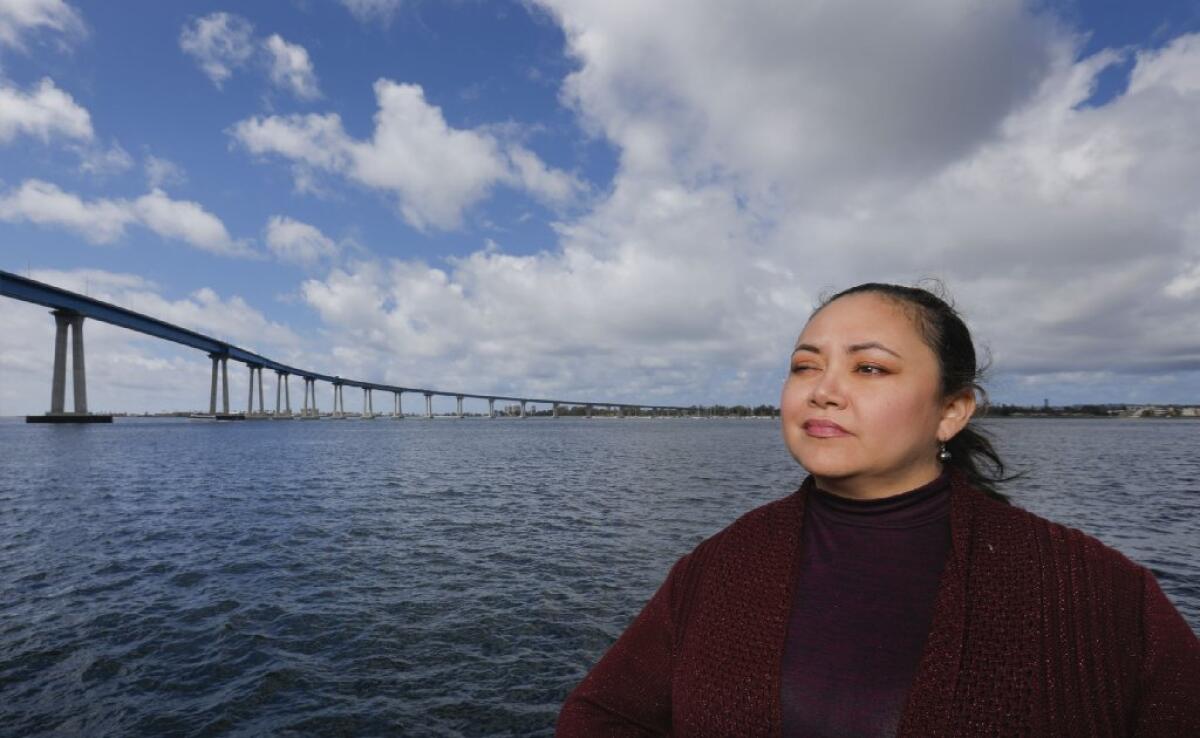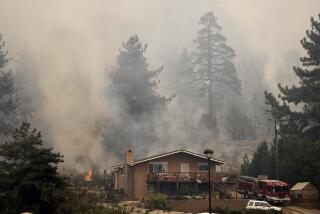Years after she survived 240-foot fall off a San Diego bridge, she meets her rescuer

SAN DIEGO â Bertha Loaiza was only 3 at the time. She has no memory of the day her mother picked her up and stepped off the side of the San Diego-Coronado Bridge.
Loaiza, now 37, survived the 240-foot fall into the bay, but her mother didnât.
She recovered from serious eye and leg injuries, believing for years that a car accident was to blame. In her grandmotherâs house where she grew up, nobody talked about what really happened on Aug. 4, 1985.
But at age 17, Loaiza came across a videotape of news coverage of her motherâs suicide and the âmiracleâ child, the first person ever to plummet off the bridge into San Diego Bay and survive. âThat looks like me,â she said of the footage showing a little girl in a hospital bed surrounded by dolls, letters and stuffed animals sent by well-wishers from as far away as Mississippi.
She watched the tape dozens of times and slowly put together the pieces. Her mother, 24-year-old Angelica Gomez, had parked her green Ford Pinto midway across the bridge. Two fishermen later pulled the woman and her child out of the water. Doctors speculated that Loaiza survived because her mother held on to her and took the brunt of the impact.
But there was a lingering and haunting question: âWhy did she take me with her?â
Loaiza saw a therapist over the years, joined a local chapter of Survivors of Suicide Loss, learned more about her motherâs mental illness, which may have been triggered by a pending divorce. Coronerâs investigators found a business card for a psychologist in her motherâs car.
âPeople with severe depression are in a really dark, ugly world, and I think she brought me with her because she believed she was the only one who could best take care of me,â Loaiza said. âAnd in a way, she did. She shielded me at the end. She hurt me, but she saved me, too.â
Last year, Loaiza shared her story with the Union-Tribune and other media as part of a grassroots campaign to get Caltrans to put up barriers on the bridge â more than 400 people have died since the span opened in 1969 â and as a way to raise awareness and ease the shame that often surrounds suicide.
She caught the attention of local mental-health advocacy groups, who gave her awards, and she caught the eye of one particular internet reader in Nevada.
He was there that day in 1985.
Steven LeMaire had been on the job as a Harbor Police officer for nine months â âa rookie, really,â he said.
It was a Sunday afternoon. His patrol beat was in the north bay, around Shelter Island and Harbor Island. He should have been nowhere near the bridge. But the boat patrolling the south bay had engine trouble, and LeMaire and his partner had been diverted to help them.
Passing near the bridge, he looked up and saw that traffic was stopped. He told his partner, who said it was probably routine maintenance. âBut itâs Sunday,â LeMaire said.
Thatâs when the call came in.
They raced to a spot where a couple of civilian boats were gathered. LeMaire could see one guy in the water, holding a woman. He reached to pull her into his boat when someone told him there was another victim.
âI went to the bow and they handed me Bertha,â he said. âI wasnât expecting a child.â
He could see a compound fracture in one leg, and she wasnât breathing. He started CPR.
âShe woke up and looked at me and I could see the terror in her eyes,â he said. âThen she went unconscious again.â He continued resuscitating her.
They motored to a pier at the foot of Crosby Street, where ambulances were waiting. LeMaire and his partner helped move the victims and then returned to their patrol duties.
âIt was a big deal, and then they were gone,â he said.
Months later, Arthur G. LeBlanc, the Harbor Police chief, sent him a letter of commendation. âYour quick and effective action to triage the two victims, initiate first aid, and administer oxygen to the child was directly responsible for saving the life of the youngster,â it read. âYou will be happy to know that follow-up reports indicate the child has recovered completely, and you can take credit for that life.â
Years went by. An injury forced LeMaire to retire from the Harbor Police. He worked security for an airline and is now, at age 59, an investigator for the state of Nevada. Everywhere he went, the girl from the bridge followed him, in his nightmares.
âI thought I was a tough guy,â he said. âIâd been in the military. But I wasnât ready for that. I couldnât get the image out of my head of her waking up and looking at me. I struggled with it for a long time before it finally subsided.â
He said he rarely talked about the incident with co-workers, but at a luncheon earlier this year, he told a few of them the story. That got him thinking about the girl, wondering how her life had turned out. He went online and read an April 2018 Union-Tribune story about Loaiza coming forward to talk about suicide and mental health and the Coronado bridge.
âI am glad she has made it to the point she is now in life,â LeMaire wrote in an e-mail to a Union-Tribune reporter. âIf you happen to talk to her, please give her my best.â
âI owe him my life,â Loaiza said of LeMaire. âI wouldnât be here if he had given up on me.â
And, she said, she had a lot to be thankful for since she went public with her story.
Momentum seems to be building to put suicide barriers on the bridge. She started a Survivors of Suicide Loss support group for Spanish speakers, which meets monthly at the YMCA in the Otay Mesa West neighborhood of southern San Diego. She received an award as a âstigma busterâ from the local chapter of the National Alliance on Mental Illness.
Loaiza says she looks at all she has now â a husband, two children, a job in healthcare, her advocacy projects â and connects it to that Sunday afternoon more than three decades ago. âIt feels like things are coming full circle,â she said.
Loaiza and LeMaire have talked on the phone a few times. Theyâre friends on Facebook. And on Friday they met in person.
LeMaire was in San Diego, finishing up a cruise. He and Loaiza met for lunch. She brought her family.
There were hugs, and the kind of smiles that come with a holiday gift that neither saw coming.
âReunited,â Loaiza said, âand in a much happier setting.â
Wilkens writes for the San Diego-Union Tribune
More to Read
Sign up for Essential California
The most important California stories and recommendations in your inbox every morning.
You may occasionally receive promotional content from the Los Angeles Times.










